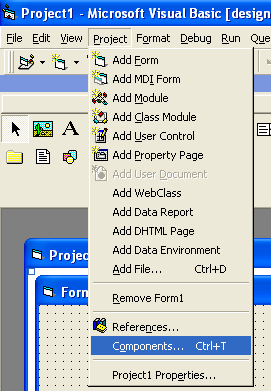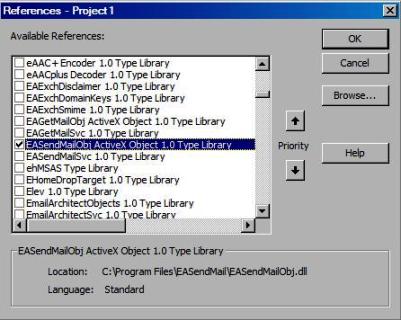Visual Basic 6.0 Dll Files

I have created a DLL files using C#. How can i use it in Visual Basic 6.0? Please help me with this. Nov 24, 2013 When running the Microsoft Visual Basic 6.0 Package and. Dll files on your computer.
KB Articles:. This package updates two Microsoft Visual Basic 6.0 Common Controls: mscomctl.ocx and comctl32.ocx to address the issues described in the KB articles noted in the Related Resources section on this page. This package will not install these Common Controls if they do not already exist on the target system. This package cannot be uninstalled. This package is provided under the terms of the End User License Agreement and is intended for the following customers:.
Customers who are Microsoft Visual Basic 6.0 and/or Microsoft Visual Studio 6.0 licensees. Customers who are not licensees of Microsoft Visual Basic 6.0 nor Microsoft Visual Studio 6.0 but are using older versions of the two Common Controls. Mainstream Support for Microsoft Visual Basic 6.0 ended on March 31, 2005. However, we are releasing this non-security related package because it contains improvements that were ready for release just prior to the end of Mainstream Support. Microsoft Visual Basic 6.0 has transitioned to Extended Support which runs through March 31, 2008. Microsoft is not extending the Mainstream Support phase for Microsoft Visual Basic 6.0 in any way.
Hello I have a dll which was created in.net. I can use the same dll in Visual Studio 2005 but i cant use it in visual basic 6.0. I tried converting it using the regasm tool but it shows some warnings and the tlb doesn't contain all the classes. I used the same dll with Visual Studio 2005 and checked mark in used for COM interop, and this also creates the tlb but same error: Warning: The public struct contains one or more non-public fields that will be exported. And such warnings are 4. Please let me know wht can i do?
Regards Hitesh. Rapidman, According to your question on using.NET DLL in VB 6.0, I would like to provide you the suggestions as follows: 1. In order to make your question more clear especially the information on DLL, you need to provide more information on the DLL developed in.NET, such as Class Library with third-party components reference. When you want to expose types in a Microsoft.NET assembly to Component Object Model (COM) applications, consider the following COM interop requirements at design time.

Managed types (class, interface, struct, enum, and others) interact well with COM client applications when you follow the guidelines in the article bleow: Hope that can help you. Rapidman, Thanks for the repy. This is another issue on.NET assembly security. In my opinion, Shawn Farkas - MS provides the best explanation on this issue in the thread below: You can take a look at the replies and read the contents of the tools such as. This can help you to better understand your problem on CLI header issue. Private assemblies are available only to clients in the same directory structure as the assembly; shared assemblies are available to any local COM application. All assemblies and type libraries must be registered in the Windows registry so COM clients can use the managed types transparently.
For further information on private assembly, see the article. Rapidman, According to your question on using.NET DLL in VB 6.0, I would like to provide you the suggestions as follows: 1. In order to make your question more clear especially the information on DLL, you need to provide more information on the DLL developed in.NET, such as Class Library with third-party components reference. When you want to expose types in a Microsoft.NET assembly to Component Object Model (COM) applications, consider the following COM interop requirements at design time. Managed types (class, interface, struct, enum, and others) interact well with COM client applications when you follow the guidelines in the article bleow: Hope that can help you. Hello Mr Bruno, I have read the article and actually this was the article i referred to when i converted the dll.
The problem is here is that only the public classes are converted to tlb but the private are not, as type libraries doesn't support private classes as i understand. So, the problem now is how do i proceed now? The tlb is there but not complete. I used the regsam tool and also compiled with interop checked. I used the dll in visual basic 2005, and compiled using vb 2005.

Could you help me if i send you the dll file? I tried to use the reflector tool to disassemble it, and it shows many private classes, but am not being able to compile it then as when i try to convert the private class into public, it gives error as: 'The item doesn't contain a CLI header.'
Captain scarlett and her pirate. Oct 20, 2012 This Video guide will show you how to unlock Borderlands 2 Captain Scarlett and Her Pirate’s Booty DLC.
Could you please suggest me wht to do next? Rapidman, Thanks for the repy. This is another issue on.NET assembly security. In my opinion, Shawn Farkas - MS provides the best explanation on this issue in the thread below: You can take a look at the replies and read the contents of the tools such as. This can help you to better understand your problem on CLI header issue. Private assemblies are available only to clients in the same directory structure as the assembly; shared assemblies are available to any local COM application.
All assemblies and type libraries must be registered in the Windows registry so COM clients can use the managed types transparently. For further information on private assembly, see the article. Rapid, Thanks for your mail. The following information shows I use RegAsm and /tlb result in Visual Studio 2008 Command Prompt on my local machine: C: Program Files Microsoft Visual Studio 9.0 VCregasm C: DLL Devshock.Protocol.Smpp.dll Microsoft (R).NET Framework Assembly Registration Utility 2.0.
Visual Basic 6.0
Copyright (C) Microsoft Corporation 1998-2004. All rights reserved.
Types registered successfully C: Program Files Microsoft Visual Studio 9.0 VCregasm /tlb C: DLL Devshock.Protocol.Smpp.dll Microsoft (R).NET Framework Assembly Registration Utility 2.0. Copyright (C) Microsoft Corporation 1998-2004. All rights reserved. Types registered successfully Assembly exported to 'C: DLL Devshock.Protocol.Smpp.tlb', and the type library was registered successfully Then I add the reference of the DLL, create the new instance and all the components can be shown in the Intellisense.
I am using Windows Server 2003 and Visual Basic 2008 Express Edition. I am using Visual Studio 2005, VS 8.0 and Windows Xp.
IN the original dll file, we can see all the components, when i see it in Visual BAsic 2005, added as reference. But as far as the tlb version is concerned, though no errors are seen in the prompt, all the components are not see.
I tested it with the reflector tool as well. What is the size of the tlb that you generated. The one i generated was abt 47 Kb. Could you please send me the tlb file in my address:. So that i can compare you and mine results.
But i think its going to be the same. I hope not though. Maybe tyhe tlb u converted has all the components. The one i converted all did not have any errors but not all components are seen in the object Browser.
Regards Hitesh. Rapidman, Thanks for your follow up and the mail with specific screen shot. I can reproduce all the steps in both VS 2008 and VB 6 IDE on my local machine. Furthermore, I notice that this assembly is not strong name without.snk file. I suggest you to use al /out: to sign your Devshock.Protocol.Smpp.dll assembly with a strong name. Then you can use RegAsm /codebase switch. For further information, please see the article.
Please try to use the strong name assembly with all the Interop development.:-). Dear Bruno, Thank you very much for ur replies. I am looking thru the articles. In the mean time, I found sth else in a forum.
One guy has written these lines about the dll file i sent u: 'I had the same problem, what I did was to make a wrapper or.NET library that calls the devshock library and then Fireball I registered the library with the 'regasm.exe' util and actually I can access it from VB 6.0 and it works ok. Yes, I had to make a wrapper component in.NET that called the Devshock Library and then I called This component from my vb 6.0 Code, I used regasm.exe with the wrapper component. I think it is not possible to use the devshock library directly from VB 6.0 because it is not a strong named library.
Visual Basic 6.0 Data Types
' So, how do i make a wrapper class, what does he mean? Regards Hitesh. Rapid, The problem goes back to Com Callable Wrappers issue. Managed code components not only depend on the CLR, they require the components with which they interact to depend on the CLR. Because COM components don't operate within the CLR, they are unable to call managed code components directly.
The unmanaged code simply cannot reach into the CLR to directly call managed components. The way out of this dilemma is to use a proxy. In general terms, a proxy is a piece of software that accepts commands from a component, modifies them, and forwards them to another component. The particular type of proxy used in calling managed code from unmanaged code is known as a COM callable wrapper, or CCW. There are two prerequisites to keep in mind when creating a.NET class that will be used by COM clients. First, explicitly define an interface in your Visual Basic.NET code, and have the class implement the interface. Implementing functionality through interfaces has a major benefit for COM clients.NET keeps interfaces consistent with previous versions when generating CCWs.
This helps keep changes to your.NET server from breaking COM clients. Secondly, any class that is to be visible to COM clients must be declared public. The tools that create the CCW only define types based on public classes. The same rule applies to methods, properties, and events that will be used by COM clients.
Free Download Visual Basic 6.0 Software
Still the article I suggested you above. I hope you will read it carefully in order to create the correct components that can be called from unmanaged code. Code Block Public Class ComClass1 #Region 'COM GUIDs' ' These GUIDs provide the COM identity for this class ' and its COM interfaces. If you change them, existing ' clients will no longer be able to access the class.
Public Const ClassId As String = '6DB79AF2-F661-44AC-8458-62B06BFDD9E4' Public Const InterfaceId As String = 'EDED909C-9271-4670-BA32-109AE917B1D7' Public Const EventsId As String = '17C731B8-CE61-4B5F-B114-10F3E46153AC' #End Region ' A creatable COM class must have a Public Sub New ' without parameters. Otherwise, the class will not be ' registered in the COM registry and cannot be created ' through CreateObject. Public Sub New MyBase.New End Sub End Class. I did this again: C: Program Files Microsoft Visual Studio 8 SDK v2.0 Binsn -k sgkey.snk Microsoft (R).NET Framework Strong Name Utility Version 2.0.50727.42 Copyright (c) Microsoft Corporation.
All rights reserved. Key pair written to sgkey.snk Then i used this key pair to sign the asemby in the VB 2005 IDE. Then doing a build i get this error: Error 17 Cannot register assembly 'E: nice ds bin Release Devshock.Protocol.Smpp.dll' - access denied. Access is denied. (Exception from HRESULT: 0x80070005 (EACCESSDENIED)) Devshock.Protocol.Smpp Any idea?